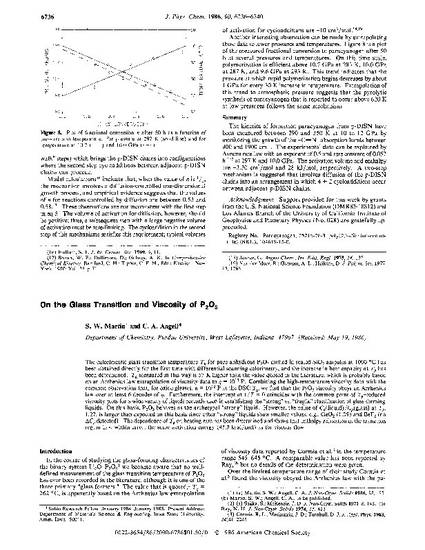
Article
On the glass transition and viscosity of phosphorus pentoxide
Journal of Physical Chemistry
(1986)
Abstract
The calorimetric glass transition temperature Tg for pure anhydrous P2Os melted in sealed Si02 ampules at 1000 “C has been obtained directly for the first time with differential scanning calorimetry, and the increase in heat capacity at Tg has been determined. Tg measured in this way is 57 K higher than the value quoted in the literature, which is probably based on an Arrhenius law extrapolation of viscosity data to 9 = lOI3 P. Combining the high-temperature viscosity data with the common observation that, for oxide glasses, 7 = 10l2 P at the DSC Tg, we find that the P,O, viscosity obeys an Arrhenius law over at least 6 decades of 7. Furthermore, the intercept at 1/T = 0 coincides with the common point of T,-reduced viscosity plots for a wide variety of liquids recently used in establishing the “strong” vs. “fragile” classification of glass-forming liquids. On this basis, P2Os behaves as the archetypal “strong” liquid. However, the value of C,,(liquid)/C,(glass) at T,, 1.27, is larger than expected on this basis since other “strong” liquids show smaller values, e.g., GeO, (1.09) and BeF2 (no AC, detected). The dependence of Tg on heating rate has been determined and shows that enthalpy relaxation in the transition region has, within error, the same activation energy (43.9 kcal/mol) as for viscous flow.
Disciplines
Publication Date
December, 1986
Publisher Statement
Reprinted with permission from Journal of Physical Chemistry 90 (1986): 6736, doi:10.1021/j100283a030. Copyright 1986 American Chemical Society.
Citation Information
C. A. Angell and Steve W. Martin. "On the glass transition and viscosity of phosphorus pentoxide" Journal of Physical Chemistry Vol. 90 Iss. 25 (1986) Available at: http://works.bepress.com/steve_martin/43/
